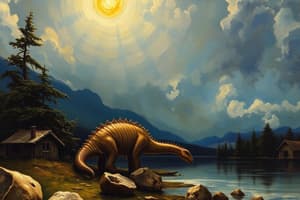Podcast
Questions and Answers
What is the defining characteristic of Cephalopods that makes them the most neurologically advanced invertebrates?
What is the defining characteristic of Cephalopods that makes them the most neurologically advanced invertebrates?
- Presence of a mantle
- Radula (ribbon string of teeth)
- Structure of nervous system (correct)
- Solid muscle body
Which class of Mollusca is described as worm-like, shell-less, and has no fossil record?
Which class of Mollusca is described as worm-like, shell-less, and has no fossil record?
- Polyplacophora
- Cephalopoda
- Caudofoveata (correct)
- Aplacophora
What is the primary function of the mantle in Mollusks?
What is the primary function of the mantle in Mollusks?
- Movement
- Reproduction
- Breathing and excretion (correct)
- Digestion
Which class of Mollusca is defined by segmented shells surrounded by a girdle?
Which class of Mollusca is defined by segmented shells surrounded by a girdle?
What is the largest extant invertebrate species known for its advanced neurological features?
What is the largest extant invertebrate species known for its advanced neurological features?
Which part of Mollusks is characterized by a ribbon string of teeth called radula?
Which part of Mollusks is characterized by a ribbon string of teeth called radula?
Which class of Mollusks includes Octopus vulgaris?
Which class of Mollusks includes Octopus vulgaris?
What is the name of the Mollusk known as 'Vampyroteuthis infernalis'?
What is the name of the Mollusk known as 'Vampyroteuthis infernalis'?
Which shell structure is typical of the class Belemnoidea?
Which shell structure is typical of the class Belemnoidea?
Among the mentioned examples, which Mollusk belongs to the class Sepiida?
Among the mentioned examples, which Mollusk belongs to the class Sepiida?
Which class does Asteroceras obtusum belong to among the Mollusks mentioned?
Which class does Asteroceras obtusum belong to among the Mollusks mentioned?
What class of Mollusca is characterized by having fully torted shells, gills, and an anterior mantle cavity?
What class of Mollusca is characterized by having fully torted shells, gills, and an anterior mantle cavity?
Which group of Mollusks is known for having untorted bodies with reduced or absent shells and mantles, and includes marine gastropods with reverse torsion?
Which group of Mollusks is known for having untorted bodies with reduced or absent shells and mantles, and includes marine gastropods with reverse torsion?
In the classification of Mollusks, which group has a modified mantle that functions as a lung and typically has conispiral shells?
In the classification of Mollusks, which group has a modified mantle that functions as a lung and typically has conispiral shells?
In Gastropods, what type of shell indicates a high-energy environment?
In Gastropods, what type of shell indicates a high-energy environment?
Which subgroup of Cephalopods is characterized by having coiled ribbed shells with complex sutures?
Which subgroup of Cephalopods is characterized by having coiled ribbed shells with complex sutures?
Which body plan of Gastropods includes examples like Trochus and Turitella?
Which body plan of Gastropods includes examples like Trochus and Turitella?
Flashcards are hidden until you start studying
Study Notes
Mollusca Phylum
- Unsegmented, soft-bodied animals
- Includes slugs, snails, squid, cuttlefish, octopus, clams, mussels, oysters, and chitin
- 2nd largest phylum next to Arthropoda; largest marine phylum
- Highly diverse in size, structure, behavior, and habitat
General Features of Mollusks
- Defined by a mantle (dorsal body wall, either with protrusions as flaps or made of calcium carbonate and conchiolin as shell)
- Used for breathing and excretion
- Body of solid muscle
- Presence of radula (ribbon string of teeth)
- Structure of nervous system
Classes of Mollusca
- Caudofoveata: worm-like, shell-less, no fossil record, no foot, calcareous spine-covered mantle
- Aplacophora: "bearing no shell", internal calcite spicules, almost no fossil record, live in water deeper than 200m in and around cnidarians
- Polyplacophora: segmented shells surrounded by girdle (band of mantle)
Cephalopods
- Modern group divided into Nautiloids and Coleoids
- Nautiloids: straight or coiled shells with simple sutures, from Late Cambrian to Recent
- Ammonoidea: coiled ribbed shells with complex sutures, from Early Devonian to end-Cretaceous
- Coleoidea: straight or coiled internal skeleton, from Carboniferous to Recent
- Include cuttlefish, squid, and octopus
Gastropods
- Fully torted with gills, anterior mantle cavity, and cap-shape or conispiral shell
- Main part of marine benthos
- Opisthobranchia: untorted with reduced/absent shell and mantle
- Pulmonata: untorted with modified mantle as lung, and conispiral shell
Gastropod Body Plans
- Trochiform: e.g. Trochus
- Turreted: e.g. Turitella
- Malcurites: e.g. Malcurites
- Turbinate: e.g. Turbo
- Discoidal: e.g. Plarobis
- Conical: e.g. GEOL 111 PALEONTOLOGY
Studying That Suits You
Use AI to generate personalized quizzes and flashcards to suit your learning preferences.




